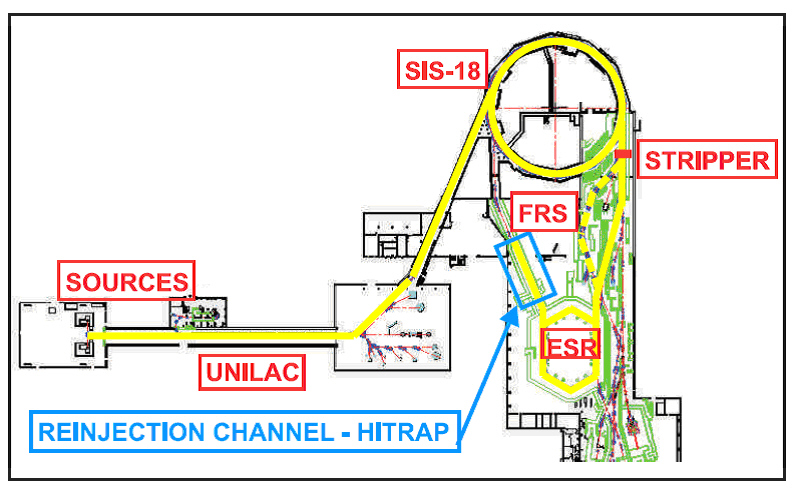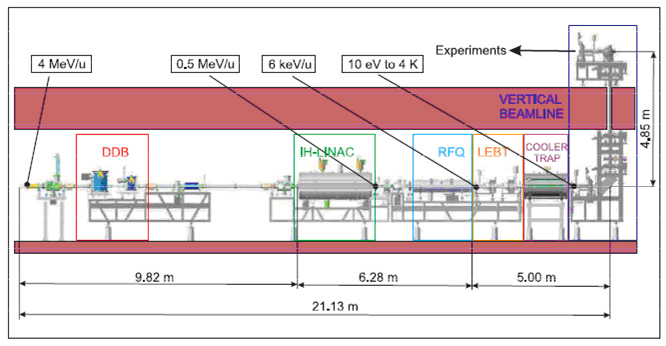The HITRAP project
The new HITRAP facility (Highly charged Ion Trapping facility) at GSI will provide highly charged ions (HCI) up to bare Uranium at low kinetic energies around a few eV. The production of HCI starts at the UNiversal LINear ACcelerator (UNILAC), where ions are first accelerated (see fig. 1). Afterwards they are injected into the Heavy Ion Synchrotron (SIS-18), a circular accelerator, where they reach energies up to 1 GeV/u. Stripping of electrons in a target-foil produces highly charged ions which are injected as bunches into the Experimental Storage Ring (ESR). There the HCI are decelerated to an energy of 4 MeV/u. Finally the ion beam is guided towards the HITRAP facility. It is placed in the ReInjection Channel, a shielded tunnel formerly hosting a beamline for reinjection of ESR beams into the SIS.

Fig. 1: The HITRAP facility located in the ReInjection Channel between SIS-18 and ESR.
The HITRAP beamline (see fig. 2) itself consists of a Double-Drift Buncher (DDB), an Interdigital H-type (IH) linear decelerator and a Radio Frequency Quadrupole (RFQ). The DDB shapes the bunch to match the acceptance of the IH-linac. The following two parts decelerate the ions, the linac to an energy of 0.5 MeV/u and the RFQ to 6 keV/u. An electrostatic beamline LEBT (Low-Energy Beam Transport) transports the ions to the Cooler Trap (Penning Trap). There the ions captured in-flight in the trap and cooled down to energies of eV or even meV via electron and resistive cooling.

Fig. 2: The HITRAP beamline and its components: Double-Drift Buncher (DDB),
Interdigital H-type (IH) linear decelerator, Radio Frequency Quadrupole (RFQ),
(Low-Energy Beam Transport (LEBT)-beamline and the cooler trap
With this novel technique of deceleration, trapping and cooling of highly charged ions the HITRAP
facility gives access to a large variety of experiments. Here an overview of the most important aspects:
Mass measurements:
The knowledge of masses provides insight into the nuclear structure. Binding energies and Q-values can be
extracted from the comparison between different nuclides. Also QED tests are possible by measurement of
masses with highest accuracy. These data have an impact on a wide range of fields, for instance, as key
parameters for a correct description of the stellar nucleosynthesis processes.
g-factor measurements:
The determination of the electron g-factor bound in a hydrogen-like ion is a sensitive test of QED.
Therefore an innovative trap setup has been developed by the Mainz-GSI collaboration.
For the upcoming experiments on uranium an accuracy of ~6x10-10 is expected. This might yield a new value
for the fine structure constant with a higher accuracy.
Laser and x-ray spectroscopy:
Accurate measurements of transitions in hydrogen-like and helium-like ions of the same species
rule out to first order the nuclear effects and allow the verification of bound-state QED effects
on the atomic structure. For these measurements the SPECTRAP (SPECtroscopy TRAP) setup, collecting
the effort of GSI, Imperial College (London), TU Darmstadt, University of Münster, Lawrence Berkeley
and Lawrence Livermore National Laboratories and Texas A&M University will be used. Its advantages are
the reduction of Doppler broadening and shift by the low energy and the high density of particles
(attainable in a trap via rotating wall compression). The resulting accuracy is expected to be three
orders of magnitude better than previously ever achieved.
Reactions:
Collision experiments reveal fundamental details of interactions as well as of the atomic structure.
In an experimental set-up being prepared by KVI Groningen and the universities of Krakow, Vienna and
St. Petersburg, the energy deposition on a surface will be addressed. Investigation topics are:
- The electron emission as a function of different parameters, as well as the predicted repulsion between the ionized surface and the partially recombined, but still positively charged, impinging ion.
- The formation and decay of hollow atoms, by means of X-ray spectroscopy to acquire new information about level schemes in HCI.
- Precision spectroscopy with the reaction microscope built up at MPI-K Heidelberg. Collisions between highly charged ions and a gas jet will be studied with the COLTRIMS (COLd Target Recoil Ion Momentum Spectroscopy) technique. The set of detectors will track projectile, recoil ion and electrons, offering a complete reconstruction of the kinematics of the charge exchange processes, which dominate at low energy.
For more information see:
- HITRAP at GSI-Webpage
- G. Maero, PHD thesis: Cooling of highly charged ions in a Penning trap for HITRAP
- pdf
